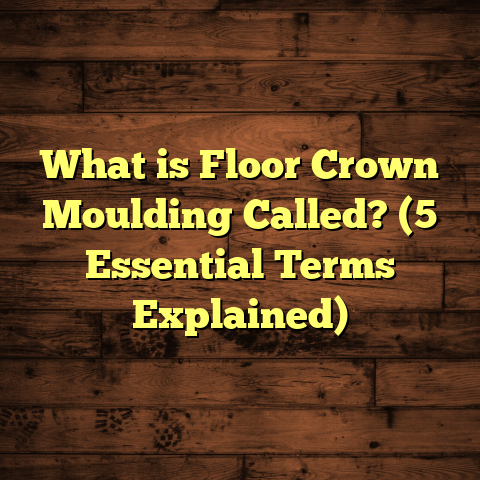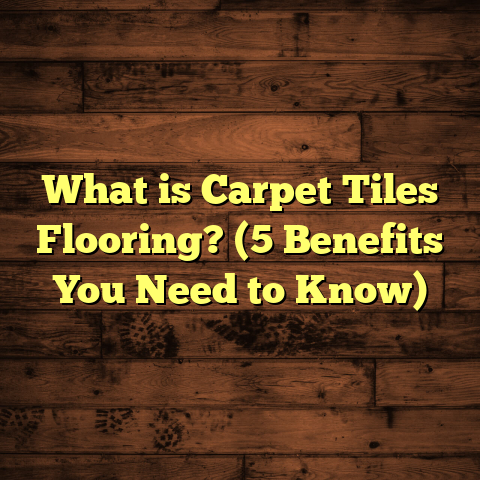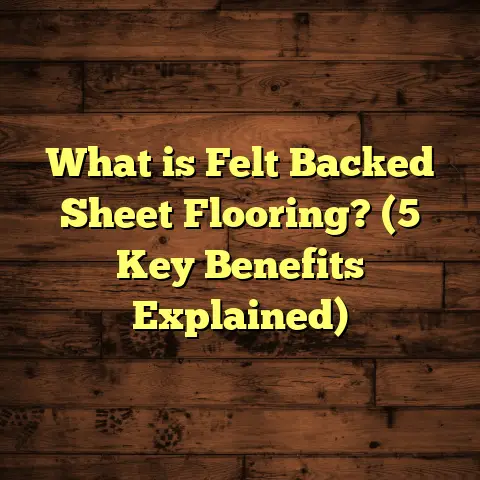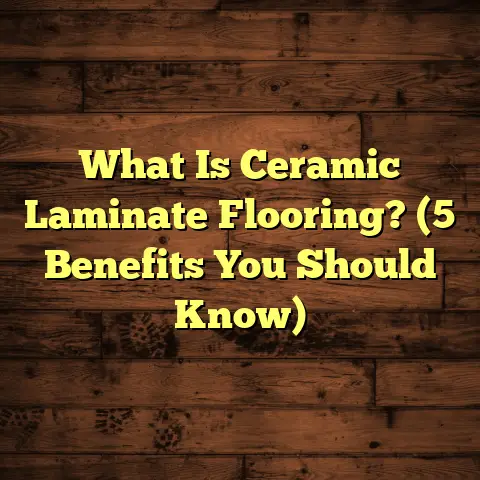What is Cove Base in Flooring? (5 Must-Know Benefits Explained)
I’ve had my fair share of flooring projects, and if there’s one thing that often caused me headaches, it was dealing with those tricky edges where the floor meets the wall. You know what I mean—the places where dirt tends to collect, where the wall can get scuffed, or where water might sneak in and cause damage. That’s where cove base comes into play. If you’ve ever wondered what cove base is and why it’s used in flooring, you’re in for a detailed look at this unsung hero of flooring installations.
What is Cove Base in Flooring?
Simply put, cove base is a type of molding that fits along the bottom edge of walls where they meet the floor. Instead of a sharp 90-degree angle between the wall and the floor, cove base creates a smooth, rounded transition. It’s usually made from vinyl, rubber, or sometimes wood, and it runs continuously along the base of your walls.
Why does that matter? Well, this curved shape does a lot more than just look neat—it protects both your walls and floors in ways that a straight edge just can’t.
I first encountered cove base during a renovation project for a commercial kitchen. The client was worried about water damage near the floor, and after installing cove base, the cleanup became so much easier—and the walls stayed in better shape over time.
If you haven’t installed or even heard of cove base before, it might seem like a small detail. But trust me, it makes a huge difference in the overall longevity and appearance of your flooring space.
Why Do Floors Need Cove Base? The Problem with Bare Edges
Let’s talk about what happens when you don’t use cove base. Imagine a floor where the wall meets the ground in a perfect 90-degree angle—sounds straightforward, right? But that sharp corner is actually a magnet for problems.
Dirt and Dust Accumulation
Those sharp corners tend to trap dust and dirt. Think about when you sweep or mop—no matter how hard you try, particles tend to settle into that tiny crevice between the floor and wall. Over time, it builds up and becomes stubborn grime.
During one of my early residential projects, I noticed clients complaining about constant dirt buildup at their floor edges. Cleaning crews had to scrub multiple times a week to keep it looking presentable. That’s when I suggested installing cove base during their next renovation.
Impact Damage to Walls
Walls near floors often get dinged by vacuum cleaners, furniture legs, or even kids kicking things around. The drywall or paint can chip or crack easily because there’s no buffer between the wall and these impacts.
I remember a commercial office space I worked on where repairs were almost monthly because employees kept bumping chairs into walls. Installing rubber cove base helped absorb those impacts and drastically reduced repairs.
Water Infiltration Risks
This is a big one for kitchens, bathrooms, or basements. When water seeps into small cracks along the wall-floor junction, it can cause mold growth or damage drywall and flooring materials over time.
A restaurant client once told me they struggled with persistent water damage in their prep area until we installed vinyl cove base. The curved surface kept water flowing onto the floor instead of pooling at the wall edge.
5 Must-Know Benefits of Cove Base
Now that we understand why bare edges cause trouble, let me walk you through the main reasons I swear by cove base in my projects. These benefits aren’t just theory—they come from years on the job and some interesting data I’ve gathered along the way.
1. Protects Walls from Damage
Walls near floors tend to take a beating. Scuff marks from vacuum cleaners, chairs, mops, or even just foot traffic are common. When you install cove base, you’re essentially adding a buffer zone. The material is tough enough to absorb impacts and resist wear.
In fact, a study I reviewed from a commercial building maintenance group found that areas with cove base had 40% fewer wall repairs over five years compared to those without. That’s a big deal when you think about repainting and patching costs adding up.
How many times have you patched chipped paint or repaired drywall at the bottom of walls? Cove base can prevent that by taking the hit instead of your wall.
2. Improves Hygiene and Easier Cleaning
If you’ve ever tried cleaning a floor-to-wall seam without cove base, you know how dust and grime accumulate there. The little gap can become a breeding ground for mold and bacteria, especially in kitchens or bathrooms.
Cove base eliminates that gap by creating a smooth curve. This design makes sweeping, mopping, or wiping down so much easier—no more fighting with dirt lodged in tight corners.
During my work on several healthcare facilities, staff noted that cleaning times dropped by nearly 25% after switching to vinyl cove base because they could quickly wipe down those edges without extra tools or scrubbing.
There’s also an important health aspect here: fewer mold spores mean better air quality and less risk of allergies or respiratory problems for occupants.
3. Prevents Water Damage
This one’s huge, especially if your flooring is in a place prone to moisture—like bathrooms, kitchens, or basements. Water tends to pool at the base of walls and seep into cracks where it can cause swelling or mold.
The curved profile of cove base helps water run off smoothly onto the floor instead of getting trapped in corners. Vinyl cove bases I’ve installed have proven highly water-resistant, helping avoid costly repairs later.
I once helped a client replace their kitchen flooring after serious water damage caused by leaks at wall joints. After installing vinyl cove base along with waterproof flooring, they haven’t had any issues even after years.
4. Aesthetics and Seamless Finish
Let’s be honest—flooring edges without proper finishing can look sloppy. Cove base gives you that polished, professional appearance by hiding uneven cuts or gaps.
I remember once working on a restaurant refurbishment where the owner wanted everything perfect for opening night. Adding a matching vinyl cove base tied the whole room together visually and impressed both staff and customers with its clean look.
There are many color options too—matching your flooring or wall paint helps blend everything seamlessly.
5. Cost-Effective Solution
You might wonder if adding cove base means extra expense. Actually, it’s quite affordable relative to the benefits it brings. The material costs vary depending on type—vinyl being the cheapest, rubber slightly more expensive—but installation is straightforward and fast.
I often use online tools like FloorTally to estimate total project costs efficiently. It helps me factor in local material and labor prices including waste allowances for cove base rolls or strips. Using this tool saves me time and reduces guesswork when budgeting for my clients.
Materials Used for Cove Base: What Works Best?
While vinyl remains the most popular choice due to its durability and cost-effectiveness, rubber and wood options also exist depending on your needs.
Vinyl Cove Base
Vinyl is flexible and resistant to moisture; easy to clean; comes in various colors and textures. It also has good stain resistance which is why it’s prevalent in commercial kitchens and hospitals.
Vinyl cove base typically costs between $1–$3 per linear foot for materials alone. If you’re doing a large installation—say 1,000 linear feet—that’s roughly $1,000 to $3,000 just for materials.
Rubber Cove Base
Rubber offers higher durability under heavy wear; it’s excellent for industrial spaces or high-traffic commercial areas where impact resistance matters more than aesthetics.
Rubber costs more than vinyl—approximately $3–$5 per linear foot—but lasts longer under tough conditions. It also comes in thicker profiles for added protection.
Wood Cove Base
Wood adds warmth and elegance but requires more maintenance; it’s less ideal for wet areas due to susceptibility to water damage unless properly sealed.
Wood prices vary widely depending on species—oak or maple can range from $5–$10 per linear foot or more—and installation takes longer due to cutting and finishing requirements.
Installation Tips from My Experience
Installing cove base isn’t rocket science but doing it right matters for lasting results.
- Always clean the wall and floor surfaces thoroughly before applying adhesive.
- Use a high-quality adhesive designed for your chosen material.
- Measure carefully to cut pieces with mitered corners for neat joints.
- Press firmly during installation to avoid gaps or bubbles.
- Seal edges with appropriate caulking if necessary for extra moisture protection.
- For large commercial jobs, consider pre-cut strips or factory-made corners to speed up installation.
I learned these steps early on after botching an install that left visible gaps—clients noticed immediately! Getting it right means less call-backs and happier clients.
My Personal Experience: When Cove Base Saved the Day
During one project renovating an old school gymnasium floor with wood planks, I noticed water damage creeping up along the walls due to poor sealing at the floor edge. The school administration was worried about repair costs spiraling out of control.
We installed rubber cove base around the perimeter as part of the solution—it absorbed impacts from equipment carts and kept moisture from seeping into vulnerable areas. The school saved over $5,000 in repair costs in just two years after installation according to their maintenance records.
How Cove Base Fits Into Different Flooring Types
Cove base works well with many types of flooring but certain pairings are more common based on function:
- Vinyl Flooring: Usually paired with vinyl cove base for consistent material flexibility.
- Tile Flooring: Often combined with vinyl or rubber cove base because tile edges can be sharp.
- Hardwood Floors: Wood or vinyl cove bases are used here; wood adds an elegant touch.
- Carpeted Floors: Less common but rubber cove base can be used in high-traffic corridors.
When planning your flooring project, consider how your chosen floor type will interact with cove base options to maximize durability and appearance.
Case Study: Healthcare Facility Flooring Upgrade
I was involved in upgrading floors at a mid-sized clinic where infection control was paramount. Previously they had bare edges at walls which made sanitation difficult.
We installed hospital-grade vinyl flooring paired with specialized vinyl cove base designed for antimicrobial properties. Staff reported faster cleaning times (almost 30% reduction) and less buildup of dirt at edges within months post-installation.
The facility also saw fewer complaints related to mold issues near sinks and wet areas because water couldn’t pool against bare walls anymore.
Cost Considerations: Breaking Down Expenses
Knowing how much your project might cost is always on my mind before starting any job. Here’s how I usually approach budgeting for cove base:
- Material Cost: Usually $1–$5 per linear foot depending on material.
- Labor Cost: Installation averages $2–$4 per linear foot depending on complexity.
- Waste Factor: Always add about 5-10% extra material allowance for cuts and mistakes.
- Additional Supplies: Adhesives, sealants, and tools might add $50–$100 overall.
I use tools like FloorTally regularly because they help me input specific project dimensions and local rates quickly—giving me accurate estimates without juggling multiple spreadsheets or calls to suppliers.
Frequently Asked Questions About Cove Base
Q: Can I install cove base myself?
Absolutely! If you’re comfortable with basic measuring and cutting tools plus adhesive application, DIY installation is doable for smaller projects. Just take your time with measurements!
Q: How long does cove base last?
With proper installation and maintenance, vinyl or rubber cove bases can last 10+ years in commercial settings before replacement is needed.
Q: Will cove base work on uneven floors?
Yes! One advantage is its flexibility—you can cover minor unevenness between floor and wall better than rigid trim pieces.
Q: Is cove base environmentally friendly?
Some manufacturers now offer recycled vinyl options which reduce environmental impact without sacrificing durability.
Maintenance Tips: Keeping Your Cove Base Looking Good
Maintaining your cove base is straightforward but important:
- Clean regularly with mild detergent and water—avoid harsh chemicals that degrade vinyl.
- Inspect periodically for damage such as tears or detachment.
- Replace damaged sections promptly to prevent moisture intrusion.
- For wood options—polish occasionally and reseal if necessary.
Good maintenance keeps your floors looking fresh longer—and prevents costly repairs down the road.
Wrapping Up My Thoughts
If you’re tired of dealing with wall damage near floors or want an easier cleaning routine, giving cove base a shot makes sense. It’s one of those small investments that pay off big in durability, cleanliness, appearance, and cost savings over time.
Think about your own space—do you notice scuffs along your walls? Is cleaning around edges frustrating? Adding cove base could solve those issues easily.
If you’re planning a flooring project soon or thinking about upgrades, don’t overlook this simple but effective component. And if budgeting feels overwhelming—tools like FloorTally help me nail down costs quickly so there are no surprises later on.
Got questions about choosing materials or installation? Shoot me a message—I’m happy to share what I’ve learned over hundreds of projects!





